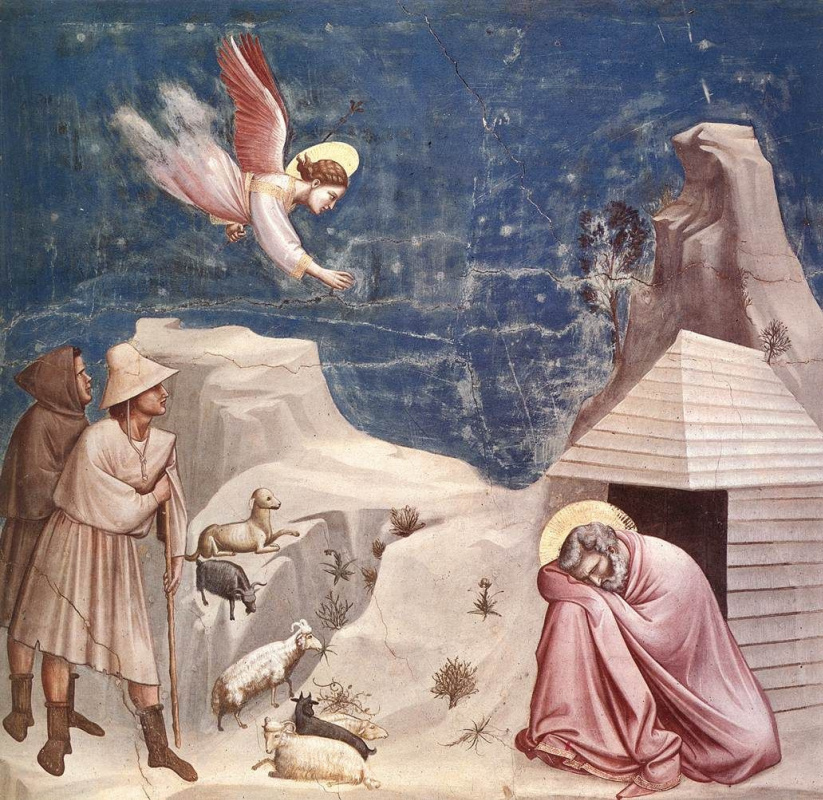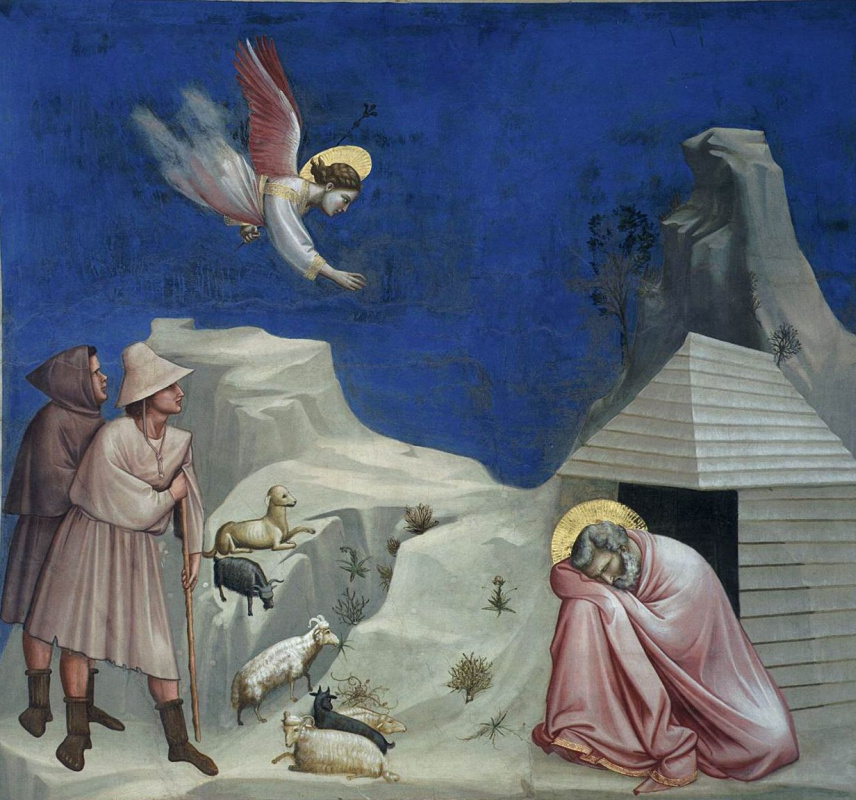log in
Enter site
Login to use Arthive functionality to the maximum
Son of Joachim. Scenes from the life of Joachim
Giotto di Bondone • Pintura, 1306, 185×200 cm
Descripción del cuadro «Son of Joachim. Scenes from the life of Joachim»
Fresco Giotto di Bondone "Dream of Joachim" illustrates an episode that we do not find in the Bible — it is not found in the Old Testament or in any of the four Gospels. Why did he interest the artist? Let us try to understand, recalling the biography of Giotto and the history of the creation of murals of the Scrovegni Chapel in Padua, among which is “the Dream of Joachim.”
Around 1303, the young, but already well-known and full of strength Florentine Giotto was invited to Padua by a rich and distinguished native of the city named Enrico Scroveni. His father, Reginaldo Scrovegni, who had recently died in Bose, was a famous usurer, bequeathed his son a great fortune, but now he died and left his son alone with doubts: what if his parent goes to hell? The assumption was justified, because usury in those days was attributed to mortal sins. A contemporary of Giotto, the poet Dante Alighieri will even put Reginaldo in the 7th circle of hell in his Divine Comedy. But Enrico was not going to put up with it. He hoped that the sins of his father could be redeemed, and for this he joined the Brotherhood of Mary and decided to build a chapel on the spot where once was the arena of the ancient amphitheater. So they began to call her - the Capella Santa Maria del Arena, and if very briefly and clearly - the Capella Scrovegni.
Giotto perfectly understood Enrico’s aspirations: Scrovelli is concerned with the fate of his own kind. And the race includes both ancestors and descendants. The fate of their heirs depends on the sinfulness or righteousness of the progenitors. Probably, with this thought, Giotto undertook to develop a design project for a chapel. On its walls in three tiers, he decided to arrange frescoes of the same size, each of which would consistently tell about episodes of the pedigree not only of Jesus Christ, but also of his mother Mary. The genealogy of Christ, as we remember, begins the "Gospel of Matthew." But Maria's pedigree is not included in canonical texts, but it can be found in the later apocryphal “Proto-Gospel of John” (not all Christians recognize it - Protestants, for example, categorically reject), which Giotto used.
So on the third, the highest tier of the right wall of the Capella del Arena appeared six frescoes, telling about the parents of the Virgin Mary - the righteous Joachim and Anna. They had reached their advanced years, but remained childless, which was interpreted as God's wrath. For this, Jaokim was expelled from the temple in which he served (1st episode) and fled to the mountains where there were no people and only the shepherds guarded their flocks (Episode 2). His wife, Anna, received an evangelism from an angelEpisode 3) that the spouses will have a daughter. At the same time, in his exile, Joachim lit an altar and offered sacrifice on it to God (4th episode). In a dream, the heavenly messenger told Joachim what his wife already knew (episode 5, see reproduction on the left). Inspired, Joachim hurried to Jerusalem to Anna, as a result of their meeting and kissing at the Golden Gate (Episode 6) the Virgin Mary was conceived. “The dream of Joachim,” is thus the fifth episode of the genealogy of Mary. Giotto writes it with calm dignity and captivating uncomplicated.
Interestingly, Giotto was the first Italian artist to begin to paint realistically. He began to make her draperies and folds not conditional, as on icons, but outlining the real contours of the human body. This is clearly seen in the clamids of the shepherds and Joachim's cloak. But the sheep on this fresco of Giotto are a reference to the artist’s youth, because, according to a biographical legend, once Giotto himself was a shepherd and struck an artist passing by Cimabue (his future teacher) by how well he depicted a sheep on a roadside stone.
Author: Anna Yesterday
Around 1303, the young, but already well-known and full of strength Florentine Giotto was invited to Padua by a rich and distinguished native of the city named Enrico Scroveni. His father, Reginaldo Scrovegni, who had recently died in Bose, was a famous usurer, bequeathed his son a great fortune, but now he died and left his son alone with doubts: what if his parent goes to hell? The assumption was justified, because usury in those days was attributed to mortal sins. A contemporary of Giotto, the poet Dante Alighieri will even put Reginaldo in the 7th circle of hell in his Divine Comedy. But Enrico was not going to put up with it. He hoped that the sins of his father could be redeemed, and for this he joined the Brotherhood of Mary and decided to build a chapel on the spot where once was the arena of the ancient amphitheater. So they began to call her - the Capella Santa Maria del Arena, and if very briefly and clearly - the Capella Scrovegni.
Giotto perfectly understood Enrico’s aspirations: Scrovelli is concerned with the fate of his own kind. And the race includes both ancestors and descendants. The fate of their heirs depends on the sinfulness or righteousness of the progenitors. Probably, with this thought, Giotto undertook to develop a design project for a chapel. On its walls in three tiers, he decided to arrange frescoes of the same size, each of which would consistently tell about episodes of the pedigree not only of Jesus Christ, but also of his mother Mary. The genealogy of Christ, as we remember, begins the "Gospel of Matthew." But Maria's pedigree is not included in canonical texts, but it can be found in the later apocryphal “Proto-Gospel of John” (not all Christians recognize it - Protestants, for example, categorically reject), which Giotto used.
So on the third, the highest tier of the right wall of the Capella del Arena appeared six frescoes, telling about the parents of the Virgin Mary - the righteous Joachim and Anna. They had reached their advanced years, but remained childless, which was interpreted as God's wrath. For this, Jaokim was expelled from the temple in which he served (1st episode) and fled to the mountains where there were no people and only the shepherds guarded their flocks (Episode 2). His wife, Anna, received an evangelism from an angelEpisode 3) that the spouses will have a daughter. At the same time, in his exile, Joachim lit an altar and offered sacrifice on it to God (4th episode). In a dream, the heavenly messenger told Joachim what his wife already knew (episode 5, see reproduction on the left). Inspired, Joachim hurried to Jerusalem to Anna, as a result of their meeting and kissing at the Golden Gate (Episode 6) the Virgin Mary was conceived. “The dream of Joachim,” is thus the fifth episode of the genealogy of Mary. Giotto writes it with calm dignity and captivating uncomplicated.
Interestingly, Giotto was the first Italian artist to begin to paint realistically. He began to make her draperies and folds not conditional, as on icons, but outlining the real contours of the human body. This is clearly seen in the clamids of the shepherds and Joachim's cloak. But the sheep on this fresco of Giotto are a reference to the artist’s youth, because, according to a biographical legend, once Giotto himself was a shepherd and struck an artist passing by Cimabue (his future teacher) by how well he depicted a sheep on a roadside stone.
Author: Anna Yesterday



